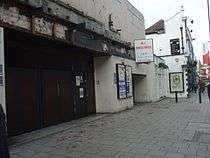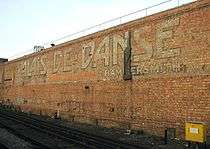Hammersmith Palais
| "The Palais" | |
 | |
|
The Hammersmith Palais de Danse entrance in May 1970. | |
| Former names | Hammersmith Palais de Danse |
|---|---|
| Address |
242 Shepherd's Bush Road London W6 7NL United Kingdom |
| Coordinates | 51°29′39″N 0°13′27″W / 51.494052°N 0.224087°WCoordinates: 51°29′39″N 0°13′27″W / 51.494052°N 0.224087°W |
| Owner |
Howard Booker and Frank Mitchell (1919-) Mecca Leisure Ltd. (1966-2000) Barclub Ltd. (2000-2003) |
| Type | Dance hall, music venue |
| Genre(s) | Entertainment |
| Capacity | 2,000[1] |
| Opened | 28 October 1919 |
| Closed | April 2007 |
| Years active | 87 |
The Hammersmith Palais de Danse, later renamed as the Hammersmith Palais, was a dance hall and entertainment venue in Hammersmith, London, England that operated from 1919 until 2007. It was the first palais de danse [nb 1] to be built in Britain.[1][3] In 2009, it was named by the Brecon Jazz Festival as one of twelve venues which had made the most important contributions to jazz music in the United Kingdom.[4]
The Palais occupied a large site on the A219 at 242 Shepherd's Bush Road, London W6, near the circular system under the A4 Hammersmith flyover. The area, one of London's key communication nodes,[1] has two London Underground stations, a bus station, and the road network at Hammersmith Broadway.
History
On the site of a former tram depot,[1] the Hammersmith Palais de Danse was opened on 28 October 1919,[1][5] by North American entrepreneurs Howard Booker and Frank Mitchell,[1][3] in order to host ballroom dancing and various kinds of dance bands, among which were the new jazz bands.[nb 2] Many of the famous jazz stars of the day appeared in concert there including American jazz singer Adelaide Hall, who performed at the venue during the week from 27 March to 2 April 1939, accompanied by the Florida Club Orchestra. In October 1933, a new maple dance floor was installed in the venue;[7] it was advertised as being "England's finest £5,000[7] maple floor".
For a period in the 1930s, part of the Palais site was used as an ice rink,[1] with the original London Lions ice hockey team using it as a base. The pipes for the ice rink were still under the dance floor, along with the rails of the original tram shed. Parts of the very well sprung dance floor had removable sections where one could clearly see all the pipes and tracks.
During the 1960s, Joe Loss and his Orchestra, with singers Rose Brennan, Ross MacManus and Larry Gretton, were a regular feature every night; except on Monday's "Record Night", when only recorded music were played and no alcohol being served from the bar. This was before the term 'discothèque' was coined. Other house bands during the 1960s and 1970s included Andy Ross, Ken Mackintosh, Tony Evans, and Zodiac.[8] Many Saturday nights, in excess of 2,000 people would visit the venue. One of the features was a huge revolving stage with a band on each side (this also caused a number of accidents when microphones and stands were left on the revolve).
The Hammersmith Palais remained a popular dance venue from its start to the late 1980s, from then on hosting mainly live music gigs, but also dance nights and private events.[9] The venue accommodated the popular School-Disco club night, which subsequently moved to the London Forum in Kentish Town. Promoters Onyx Promotions championed Brit-Asian bands and DJs including: DCS, Heera, Juggy D, Panjabi Hit Squad, Premi, RDB, Rishi Rich and Xzecutive/San-j Sanj. The Students' Union at Imperial College School of Medicine frequently hired the Palais as a venue for student nights.
The Palais played host to countless artists; among them: Bill Haley & the Comets (1974), the Beatles, the Rolling Stones, the Who, David Bowie, the Sex Pistols, Elvis Costello and the Attractions, the Cure, the Police, U2, the Jesus and Mary Chain, Robert Plant & the Strange Sensation, Hanoi Rocks and Kylie Minogue.
The venue was named in The Clash song "(White Man) In Hammersmith Palais".[5] Joe Strummer managed to get thrown out one Thursday afternoon for gaining entry without permission. It was named in the Ian Dury and the Blockheads song "Reasons to be Cheerful, Part 3". Michael Monroe's 1993-1994 band Demolition 23 recorded a track called Hammersmith Palais on Demolition 23:s self-titled album. The song is written by Michael Monroe, Jude Wilder and Little Steven. The song is a nostalgic description of the 1980s club scene in London. Bands such as PiL, the Cramps and Soft Cell, who played their "farewell" concerts there in January 1984, made the venue popular for London gig-goers.
In its last years, the Palais was owned by a company called Barclub Ltd, controller of a chain of themed bars named Po Na Na. In the early 2000s, the company briefly renamed the club Po Na Na Hammersmith, but in recognition of the venue's historic reputation, its previous name, Hammersmith Palais, was reinstated.
Closure and demolition

On 20 March 2007, despite its importance to Britain's cultural history,[9] the Hammersmith Palais was condemned for demolition.[10][11] The venue closed in April 2007, with Kasabian, Idlewild, and Jamie T among artists playing the last concerts there. The last ever gig at the Palais was a performance by Mark E. Smith's the Fall on 1 April 2007,[12] a recording of which was subsequently released as the live album Last Night at The Palais.
BBC television made a documentary about the venue's history titled Last Man at the Palais. Ballroom dancer Lyndon Wainwright danced the Last Waltz at the Palais to conclude the presentation. It was first screened on BBC Four on Christmas Eve 2007.[13]

Following its closure as a music venue, proposals for the site included use as an office and restaurant complex, or a students' hall of residence. The Hammersmith and Fulham London Borough Council had been expected to rule on the proposed demolition and development in November 2009;[14][15] however, on 27 October 2009, the council rejected plans to turn the Hammersmith Palais site into student flats.[nb 3]
In July 2010, the Planning Inspectorate held a week-long public inquiry and rejected an appeal by a development company against a council decision to block a proposed development. The developers were London & Regional (Hammersmith), who were given leave to submit an amended application.[17][18]
The Hammersmith Palais was demolished between May and June 2012.[5][9] A new building was constructed on the site, and in September 2013 opened as a student hall of residence, advertised as being on the site of the Hammersmith Palais.[19]
Notes
- ↑ Palais de danse is a lexical borrowing from French, meaning "dance palace", that refers to purpose-built commercial dance halls which appeared on Britain's high streets from the 1920s onwards.[2]
- ↑ "The Palais quickly established a reputation as a dance hall playing host in 1921 to the first jazz performance in England."[6]
- ↑ The full history of planning applications for the site can be found at the official website of the London Borough of Hammersmith and Fulham.[16]
References
- 1 2 3 4 5 6 7 Nott, James (2015). Going to the Palais: A Social and Cultural History of Dancing and Dance Halls in Britain, 1918-1960. Oxford University Press. ISBN 9780199605194. p. 18.
- ↑ Nott, James (2015). Going to the Palais: A Social and Cultural History of Dancing and Dance Halls in Britain, 1918-1960. Oxford University Press. ISBN 9780199605194. p. 3.
- 1 2 Rust, Frances (1969). Dance in Society: An Analysis of the Relationship between the Social Dance and Society in England from the Middle Ages to the Present Day. The International Library of Sociology (85). Repr. ed., 2002. Routledge. ISBN 9780415175937. p. 86.
- ↑ London Evening Standard (August 3, 2009). "Buckingham Palace Hits Right Note with Jazz Fans". London Evening Standard. Retrieved May 11, 2016
- 1 2 3 Haslam, Dave (August 29, 2015). "Boogie Wonderlands: Five of the Most Influential Nightclubs of the Last 100 Years". The Guardian. Retrieved May 10, 2016.
- ↑ Hammersmith and Fulham London Borough Council (July 1999). "10. Buildings and Structures of Merit in the Conservation Area/12. Notes". London Borough of Hammersmith and Fulham. Retrieved May 15, 2016.
- 1 2 Nott, James (2015). Going to the Palais: A Social and Cultural History of Dancing and Dance Halls in Britain, 1918-1960. Oxford University Press. ISBN 9780199605194. p. 30.
- ↑ Zodiac, Function Band and Orchestra.
- 1 2 3 Nott, James (2015). Going to the Palais: A Social and Cultural History of Dancing and Dance Halls in Britain, 1918-1960. Oxford University Press. ISBN 9780199605194. p. 94.
- ↑ Hammersmith and Fulham London Borough Council (March 20, 2007). Decision on the application for demolition permit of the Hammersmith Palais. London Borough of Hammersmith and Fulham. Retrieved May 15, 2016.
- ↑ The Fall (2009), Last Night at The Palais. Sanctuary Records. #2713432. Liner notes.
- ↑ The Fall (April 1, 2007). Last Night at The Palais (concert). Sanctuary Records. Online at YouTube. Retrieved October 16, 2016.
- ↑ "Last Man in Hammersmith Palais". BBC Four (TV). 2007. Archived from the original on 6 September 2014.
- ↑ "White man's blues". BBC News. 30 March 2007. Archived from the original on 6 September 2014.
- ↑ Bloomfield, Ruth (September 10, 2009). "Hammersmith Palais is set to be turned into student flats". London Evening Standard. Archived from the original on 6 September 2014.
- ↑ Hammersmith and Fulham London Borough Council. Property History: 000034027971 | Hammersmith Palais 242 Shepherd's Bush Road London W6 7NL. London Borough of Hammersmith and Fulham. Retrieved May 15, 2016.
- ↑ "Hammersmith Palais demolition appeal turned down". Get West London. 6 August 2010. Archived from the original on 7 September 2014.
- ↑ "Developer loses Palais appeal". h&f news. 27 July 2010. Archived from the original on 7 September 2014.
- ↑ "Pure Hammersmith - London". Pure Student Living. Archived from the original on 7 September 2014. Retrieved 7 September 2014.
Further reading
- Books
- Nott, James (2015). Going to the Palais: A Social and Cultural History of Dancing and Dance Halls in Britain, 1918-1960. Oxford University Press. ISBN 9780199605194.
- Haslam, Dave (2015). Life After Dark: A History of British Nightclubs and Music Venues. Simon & Schuster. ISBN 9780857206985.
External links
- Hammersmith Palais discography at Discogs.
- Articles
- Haslam, Dave (August 29, 2015). "Boogie Wonderlands: Five of the Most Influential Nightclubs of the Last 100 Years". The Guardian.
- Videos
- The Fall (April 1, 2007). Last Night at The Palais (concert). Sanctuary Records. Online at YouTube.
- Matthew, John (April 5, 2007). Chirps @ Hammersmith Palais. YouTube.
- Images
- Hammersmith and Fulham London Borough Council (March 10, 2008). Photographic record of the Hammersmith Palais. London Borough of Hammersmith and Fulham.
- GES019 (June 2010). "GES019 - Hammersmith Palais Theatre" (photo gallery). Guerrilla Exploring.
- De-Keyzer, Amy; WLON (February 26, 2015). "History of Hammersmith Palais" (interactive photo gallery). Get West London.
